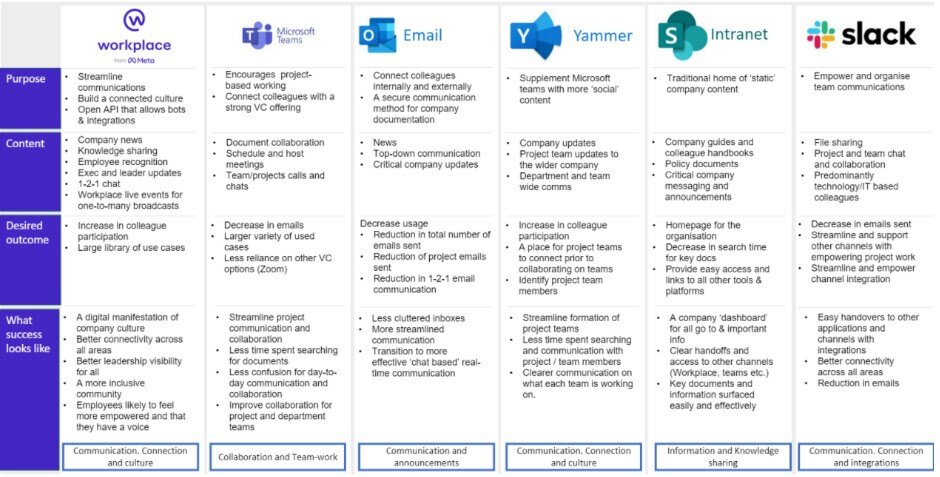How to Create an Internal Communications Matrix for Your Channels

In the modern workplace where there’s a constant influx of communication across multiple channels, an internal communications matrix can help you, your team and your employees make sense of the different channels available and how to use them to communicate effectively.
In this blog, we take you through the 8 steps to create your own internal communications matrix, along with some handy examples for each step!
What is an internal communications matrix?
Nowadays, communication with employees spans different channels for different purposes and contexts. Often leading to the question ‘what channel, when?’ An internal communications matrix is a document that helps answer this.
In essence, it’s a living, go-to document that:
- Outlines which communication channels are used by which stakeholders in the business
- Defines the purpose of each channel being used
- Prescribes when and how to use these channels appropriately
- Notes which employee personas should be targeted for different channels and communications
- Ensures that there are no overlaps between the channels in use, so that any data and communication duplication can be avoided
Advantages of an internal communication matrix
An internal communications matrix helps you ensure the right message reaches the right people at the right time, and that all employees are kept in the loop, no matter where they are or which channels they use.
The advantages of this include:
- Improved communication across your entire company
- Consistency across the workplace, regardless of office locations or hybrid practices
- Increased productivity, as employees know where to go to get the information they need
- Reduced channel overload
- More speedy communication delivery
- More targeted and specific communications, delivered timeously, reducing overall “noise”
Additionally, leveraging an internal communication matrix can help quantify and prove the return on investment for each channel in use, which can help you identify any opportunities for saving money by decommissioning channels not being fully utilised.
Steps to creating an internal communication matrix
An internal communications matrix usually looks like a tabulated document that plots various communication channels and factors along a series of columns and rows. Below we explore, step-by-step, what each of these factors include and where they should be plotted in your matrix.
1. Audit the channels you are currently using
Start off by looking at all the communication channels currently in use in your company, as well as their purpose. Plot these out at the top of your matrix in the first row, with each channel heading up its own column.
Consider how well these channels are performing by looking at their overall usage, and identify any overlaps between channels and how you’re using them. Note these findings and considerations in your communications matrix.

2. Audit the content you are sharing
Now assess the types of content you are sharing on each of these channels. What messages are you trying to communicate? Are they one-off updates or regular, repeat updates, like monthly reports? Is information bite-size or in-depth? Are downloadable attachments used?
Then, look at the content’s performance and use it to evaluate the effectiveness of the tool for specific content types. Low performance could indicate that the channel is wrong for the type of content being shared or vice versa, or that a different approach may be needed entirely.

3. Review your employee personas
Not all employees are the same, and different people have different communication needs at different times. This is why it’s important to create or update your employee persona profiles across your business.
Once you have these personas defined, you can then map out their user journeys to get a better sense of what your colleagues’ days look like and what information they require at different points in their day, as well as which channels they default to when looking for this information.
When reviewing your internal communications matrix in line with your employee personas, consider if all your personas are accounted for with all your current in-use channels, and whether the content you’re delivering across the channels meets their communication needs.
4. Document your goals
Within your internal communications matrix, it’s also important to define your desired outcome for each of the communication channels in use. Consider what the purpose of each channel is and how best that purpose serves your company’s own communication needs and goals.

5. Set what success looks like
Here, think about what optimal usage and adoption looks like for each channel, and what reaching each desired outcome would mean for your internal communications strategy and goals.
Having a clearly articulated definition of “success” can help guide your use of each communication channel, the types of content you share on them, and which personas to communicate with using each of these channels.

6. Share, communicate & train
Once you’ve plotted out all the necessary channels and considerations, it’s time to share your internal communications matrix across your business and provide training to those responsible for communications, especially leadership.
When providing training, work with leaders to ensure they understand how to use each channel, and how it benefits them, their teams and the business. It's also worth recruiting “communication champions” across departments, locations and seniority levels to help promote the full and proper use of all communication channels being used in the business, in accordance with the internal communications matrix.
Finally, ensure the matrix and all associated knowledge and documentation is stored somewhere that’s easily accessible to anyone within the company (refer to your matrix to find the best channel for this!).
7. Consider campaigns
To help encourage engagement with the internal communications matrix, and the proper use of all internal communication channels, it’s worth running internal communication campaigns.
Drawing on the matrix, develop a plan that drives the activation and adoption of your business communication channels, by showing how and why the channels are used, and what types of content each employee persona can expect to see on each channel.
8. Review, optimise & reinforce
After some time has passed, you should review your communication channels in line with your matrix and see where there’s room for optimisation and reinforcement. Your timeline for review will be unique to your company, the number of employees you have, and the amount of time it would realistically take to see widespread communication improvements, but it’s important to refer back to your communication goals and what success looks like to your business.
Once your communication matrix has been in play for an amount of time relevant to your company, identify gaps and optimise accordingly. Also see if there are areas that require further development and training.
Conclusion
By taking an in-depth look at your company’s communications channels and the content shared on them, you can start improving internal communication across the board. This will in turn lead to greater employee-business alignment and a better employee experience overall, resulting in an easier, more productive work environment for all.
At Cocentric, we use the best technology to unlock the best in your people. Our employee experience and digital deployment experts can help you carry out an internal communications matrix, and then develop the best course of action to help address the issues that come with internal communications. With our know-how and technical expertise, your company can be well on its way to a culture of effective communication.
Get in touch to see how Cocentric can help you carry out a internal comms matrix for your channels.





